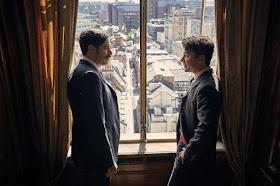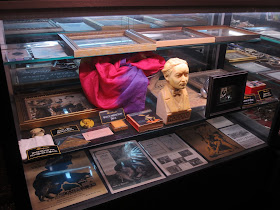This Memorial Day marks the 116th anniversary of Houdini's first trip to Europe on May 30, 1900. To mark the occasion, here's a look back at that all-important year.
The year 1900 was transformative for Houdini. After nearly a decade of hard struggle, he was now on a path to becoming one of the most famous entertainers of all time. But it wasn't going to be all smooth sailing.
Having signed with vaudeville manager Martin Beck in
1899 -- and achieving success on Beck's Orpheum circuit out west -- "Houdini The King of Handcuffs" kicked off the new year playing Keith's flagship theater in Boston. Here, the press compared him favorably with another recent magical sensation, Ching Ling Foo. Houdini featured the quote on his advertising.
In February, Houdini experienced embarrassment at the New York Theater when Bess got stuck in the Metamorphosis trunk. The story
made the papers. Following an engagement at Shea's Theater in Toronto, Houdini was back playing the Keith's circuit in April, performing nude jail escapes in Chicago and Kansas City that garnered favorable press. (Some cite these as Houdini's very first jail escapes, but he had done jail escapes in Holyoke and Halifax in 1895 and 1896.)
Under Beck's guidance, Houdini had achieved a respectable measure of success. But he was not yet a regular headliner, despite his flair for getting publicity. Beck also took a hefty 20% cut, which Houdini did not like and said so. Beck reminded him of the situation when they met a year earlier: "No managers would believe your act was fit for vaudeville, they all considered it a museum act."
Popular mythology characterizes Houdini's mid-year trip to Europe as a bold all-or-nothing gamble, that Harry and Bess had $20 in their pockets and a one-way ticket. The truth was Houdini was already earning up to $400 a week on the Keith's circuit. It was typical to send acts to Europe to enhance their reputation in the states, and the European trip was a calculated effort by Beck to "boom him to the top-notch." The trip had originally been planned for the Fall of 1899, but England's Boer War had depressed the entertainment economy, so it was postponed until Spring.
Beck's European representative, Richard Pitrot, made the arrangements. Pitrot assured Harry that he had advanced bookings in Berlin, London, and Paris. Houdini would be advertised as "
America's Sensation," and by now, he had an impressive scrapbook of clippings to back that up. On May 30, 1900, Harry and Bess set sail on the
S.S. Kensington.
Houdini battled seasickness for the entire crossing. At one point, Bess tied him to his bunk when, delirious, he threatened to throw himself overboard. When they landed in London, they discovered no bookings had been made. Houdini wrote, "[Pitrot] was a Dam Liar." In the showbiz parlance of the time, they were "
shipwrecked."
These first weeks in London must have been a nightmare for Houdini. After finally breaking through, here he was in a new country with no bookings and theater managers who were not impressed with his scrapbook or tales of breaking out of American jails. Harry and Bess found lodging at a boarding house popular with magicians at 10 Kepple Street (T. Nelson Downs and Howard Thurston would pass through at this time). Eventually, Houdini met Harry Day, a young English agent, who arranged for an audition at the prestigious Alhambra Theatre in Leicester Square.
Legend tells of how Houdini won his engagement at the Alhambra by making a bold all-or-nothing bet with manager C. Dundas Slater that he could escape handcuffs at
Scotland Yard. It's a great story, but all evidence points to a more conventional start. By his own account, Houdini gave several trial performances at the Alhambra, one for Scotland Yard detectives, and finally won the 10th spot on the bill. Interestingly, the 14th spot that same week was another newcomer, Chung Ling Soo (William Robinson), who would become famous in his own right and Houdini's good friend.
On his first night, Houdini was challenged onstage by
Cirnoc, who claimed to have originated the Handcuff Act. Houdini defeated his rival with a pair of Bean Giant handcuffs. The unexpected confrontation made the papers. With his handcuff escapes, Metamorphosis, and card magic (which was still a part of his act at this time), Houdini became the hit of London. Originally booked for two weeks, the Alhambra held him over for two full months.
Riding high, Houdini postponed his return to America, where he was booked to play the Keith circuit in August. Instead, he accepted bookings in Germany. Martin Beck cautioned him against getting a "swelled head."
Under Kaiser Wilhelm II, Germany was an authoritarian state, and all entertainers had to be certified by the police. On September 20th, Houdini visited the new police headquarters in Berlin. Before 300 officers, he was strip-searched, heavily manacled, and gagged. Allowed to work under a sheet, he freed himself in a matter of minutes. The police grudgingly approved his act: "At this time, we are unable to explain the way in which the locks are opened and remain undamaged." But Houdini would continue to butt heads with the German police in the years to come.
The German public went wild for the brash young American who could not be restrained, and Houdini quickly became as much a sensation as he had been in the UK. Houdini believed it helped that he spoke to audiences in his native German. "It makes them all friendly with me before I have performed a single trick." However, newspapers poked fun at his pronunciation.
After a month-long engagement at the Central Theater in Dresden (Cirnoc appeared at an opposition theater), Houdini moved to the Wintergarten in Berlin, where he headlined for two months. Tickets were sold four and five days in advance, and the crowds grew so large that the police stepped in and refused to allow any more tickets to be sold. The Wintergarten paid 4000 marks to a theatre in Vienna to hold Houdini for an extra month.
Besieged now with imitators, Houdini decided to create one of his own. He cabled his brother Theo in New York, "Come on over, the apples are ripe." In November, Dash booked passage on the German liner
Deutschland and met Harry in Berlin. There, he discovered Houdini had created a duplicate act for him, right down an assistant named Miss Trixy, who would act as his very own Bess in the substitution trunk. Houdini had also come up with his new name: Hardeen.
With theater managers now fighting for his services, Houdini played a 10-day stint at the Circus Variete in Magdeburg, Germany. The Variete offered to pay the Alhambra a fine equal to two weeks' salary if they could retain Houdini for another two weeks. The Alhambra refused. They wanted Houdini back in London. Houdini boasted that it was "a record for a return engagement at this world-famous theater." For days, men paraded up and down the street in front of the Alhambra with sandwich boards heralding Houdini's return.
Houdini opened at the Alhambra on December 14 and played out the rest of the year to jam-packed houses. His billing was featured above the famous Alhambra ballets, which, according to Houdini, "is something unheard of!"
In time, Houdini would create a new series of dramatic posters to replace his "America's Sensation" sheet. This time the posters proclaimed him, without exaggeration, as
Europe's Eclipsing Sensation!
Related posts:

















































